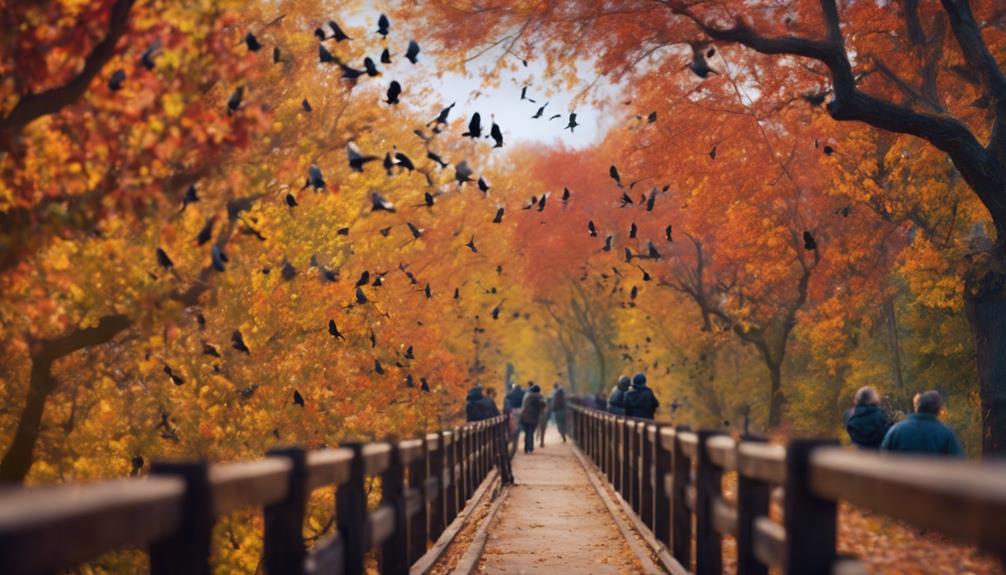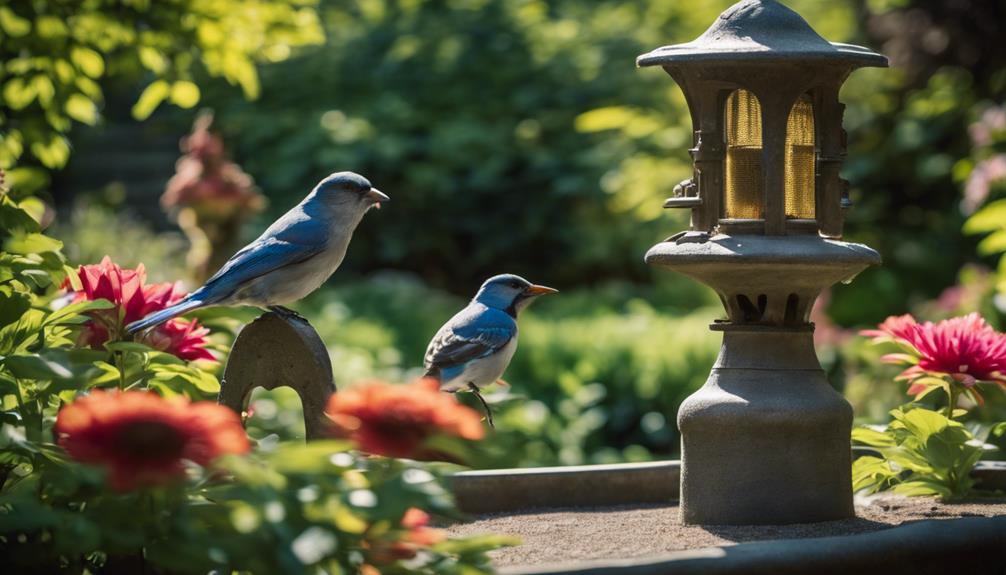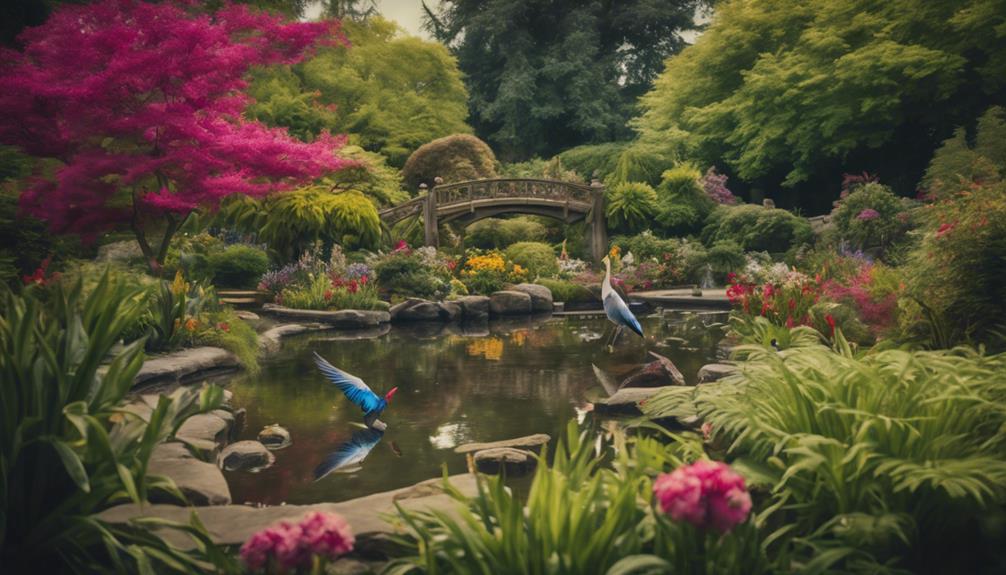When you explore Dow Gardens, you'll find that bird watching is elevated—quite literally—by the Canopy Walk, which provides stunning views from 40 feet above the ground. This unique vantage point lets you observe fascinating avian behaviors and flight patterns that are often missed from the forest floor. You might spot winter species like Northern Cardinals and Red-tailed Hawks, or even encounter deer and rabbits as you wander. Enhance your skills by joining a guided tour, where experts will share tips on using binoculars and field guides effectively. But what truly sets Dow Gardens apart isn't just the birds you'll see.
Key Takeaways
- The Canopy Walk offers a 1,400-foot treetop experience perfect for observing bird flight patterns and social behaviors.
- Winter bird species at Dow Gardens include Northern Cardinals, Black-capped Chickadees, and Bald Eagles.
- Guided birdwatching tours and workshops enhance the experience with expert insights and identification tips.
- Birdwatchers can enjoy complimentary beverages and pastries at the Café during their visit.
- The Canopy Walk provides panoramic views ideal for bird photography and appreciating winter wildlife.
Canopy Walk Vantage Points

The Canopy Walk at Dow Gardens, standing 40 feet above the ground, lets you observe avian behavior and seasonal changes from an unparalleled elevated vantage point. Stretching 1,400 feet, this elevated walkway immerses you in the treetops, offering panoramic views that are both breathtaking and scientifically intriguing.
As you stroll along the Canopy Walk, the elevation allows you to observe birds at eye level, providing a unique perspective on their flight patterns, foraging behaviors, and social interactions.
During the winter months, the Canopy Walk transforms into a vantage point for studying how avian species adapt to colder temperatures. You can notice the behavioral adaptations of birds, such as increased foraging activity and the formation of mixed-species flocks, which enhance their chances of finding food and avoiding predators. The snowy landscape beneath you creates a stunning contrast, highlighting the movements and colors of various bird species against the white backdrop.
The Canopy Walk at Dow Gardens also offers exceptional opportunities to understand seasonal changes. From this elevated perspective, you can observe the phenological shifts in the environment, such as the timing of leaf fall, snow accumulation, and the subtle changes in light patterns, all of which influence avian behavior.
The ability to witness these dynamics from a consistent elevation provides valuable insights into how birds and other wildlife interact with their habitat throughout the year.
In essence, the Canopy Walk at Dow Gardens isn't just a scenic route; it's a living laboratory. It allows you to explore the complexities of avian ecology and seasonal adaptations from a vantage point that's both immersive and educational.
Winter Bird Species
Exploring Dow Gardens in winter reveals a fascinating array of bird species, each adapting uniquely to the cold season. As you wander through the snow-covered paths, you'll encounter Northern Cardinals, their bright red plumage contrasting vividly against the white backdrop. These birds aren't just visually striking; they also exhibit intriguing behavioral adaptations, such as fluffing their feathers to trap heat and maintain body warmth.
In the denser thickets, listen for the distinctive calls of Black-capped Chickadees. These small birds possess exceptional memory, allowing them to recall the locations of hundreds of food caches they've stored during the autumn months. Their ability to lower their body temperature during cold nights is a remarkable physiological adaptation to winter's harsh conditions.
Among the woodpeckers, keep an eye out for Downy and Hairy Woodpeckers drumming on tree trunks, searching for insects and larvae hidden beneath the bark. The Red-bellied Woodpecker, with its striking red cap and nape, is another winter resident you can spot. These woodpeckers play an essential role in controlling insect populations, thereby maintaining a balanced habitat.
The open fields and skies of Dow Gardens provide a hunting ground for raptors like Red-tailed Hawks and Bald Eagles. These birds of prey are masters of the sky, utilizing their keen vision to spot potential meals from great heights.
Dow Gardens' diverse habitat, bolstered by over 1700 plant species, supports a wide range of wintering birds like American Goldfinches, Tufted Titmice, and White-breasted Nuthatches. Their presence underscores the Gardens' importance as a sanctuary where birds find both food and shelter during the winter months.
Birdwatching Tips

Frequently, successful birdwatching at Dow Gardens hinges on mastering the use of binoculars to observe the intricate details of various bird species. By focusing on the fine plumage patterns and behavioral nuances, you can better appreciate the avian life within the Forest of Dow Gardens. Make sure your binoculars are properly adjusted for your eyesight; a clear, sharp image will make identifying species much easier.
One of the most effective birdwatching tips is to familiarize yourself with field guides and smartphone apps. These resources can greatly enhance your ability to identify birds quickly and accurately. Apps like Merlin Bird ID or Audubon Bird Guide offer real-time identification assistance, which is particularly helpful when you're exploring the trails of Whiting Forest.
Joining guided birdwatching tours is another excellent way to sharpen your skills. These tours often lead through prime bird habitats in Dow Gardens, providing opportunities to see a wide variety of species. The experienced guides will share their knowledge, pointing out distinguishing features such as beak shapes and song patterns.
If you're new to birdwatching or forgot your gear, the Birding Basics Workshop offers loaner binoculars, ensuring you don't miss out on any avian action. This workshop is designed to enhance your birdwatching experience by teaching you practical skills in a hands-on environment.
After a rewarding birdwatching session, treat yourself to a complimentary beverage and pastry at the Café. Reflecting on your sightings while enjoying a snack can be the perfect way to end your visit to Dow Gardens. Remember, patience and practice are key—each visit to the Forest of Dow Gardens brings new opportunities to improve your birdwatching expertise.
Wildlife Encounters
Throughout the winter months, you'll find a serene haven at Dow Gardens, where you can observe deer gracefully moving through the snowy terrain, or spot rabbits burrowing into their cozy shelters. This quiet, picturesque setting provides a unique opportunity for wildlife enthusiasts to immerse themselves in the natural world.
Deer, often seen in groups known as herds, exhibit fascinating behaviors as they forage for food beneath the snow. Watch closely, and you'll notice how they use their hooves to uncover vegetation, showcasing their proof of adaptability to harsh winter conditions. The sight of their majestic antlers against the winter landscape is a highlight for any observer.
Rabbits at Dow Gardens demonstrate remarkable survival strategies during winter. You'll see them creating intricate burrows, which serve as both shelter and protection from predators. These burrows, often lined with grass and fur, are a sign of their instinctual drive for warmth and safety.
For birdwatching enthusiasts, winter at Dow Gardens offers unparalleled opportunities to observe a variety of bird species. The bare branches and snowy ground make it easier to spot birds like cardinals, with their vivid red plumage, and chickadees, known for their distinctive calls. Look for woodpeckers tapping on tree trunks, searching for insects hidden beneath the bark – a behavior known as foraging.
The tranquility of Dow Gardens during winter makes it an ideal retreat for those passionate about wildlife observation. Whether you're captivated by the elegant movements of deer, the resourcefulness of rabbits, or the vibrant birdlife, Dow Gardens provides a perfect backdrop for appreciating nature's wonders.
Seasonal Events

Winter at Dow Gardens offers a myriad of seasonal events, such as candlelight walks and winter gardening workshops, that invite visitors to engage deeply with the serene, snow-covered landscape. These events transform the garden into a winter wonderland, providing unique ways to connect with the natural environment and its inhabitants.
As you wander through the gardens, you'll find that the blanket of snow muffles sounds, creating a tranquil atmosphere perfect for birdwatching. The candlelight walks, held on select evenings, guide you along softly lit paths, highlighting the beauty of frost-covered plants and allowing for peaceful reflection. During these walks, keen observers might spot cardinals, woodpeckers, and other winter-resilient avians going about their daily routines.
The winter gardening workshops are a fantastic opportunity for visitors to learn about maintaining gardens in colder climates. These workshops cover topics like winter pruning techniques and plant protection methods, ensuring your garden thrives year-round. Expert horticulturists also demonstrate how to create habitats that support wildlife during the harsh winter months.
Special holiday events at Dow Gardens include photography classes designed to teach you how to capture the unique beauty of the winter landscape. These classes are perfect for both amateur and seasoned photographers looking to hone their skills in a picturesque setting.
Here are some highlights of the winter events:
- Candlelight walks
- Winter gardening workshops
- Guided tours focusing on winter ecology
- Holiday-themed photography classes
- Peaceful birdwatching opportunities
Planning Your Visit
After delighting in Dow Gardens' winter offerings, you'll want to plan your visit meticulously to make the most of the serene landscapes and enriching activities available. Start at the Visitor Center, your hub for information and resources. Here, you can pick up a site map, register for guided tours, and learn about the specific bird species that frequent the gardens during winter. The knowledgeable staff can provide insights into bird behaviors and migratory patterns, helping you maximize your bird-watching experience.
Don't miss the Canopy Walk, an integral part of your visit. This 1,400-foot-long elevated walkway stands 40 feet above the ground, offering a bird's-eye view of the winter landscape. It's an excellent vantage point for observing avian species in their natural habitat. From this height, you can spot various bird species, like chickadees and woodpeckers, engaging in their winter foraging behaviors. The Canopy Walk also provides an unparalleled perspective of the gardens' winter flora, making it a must-see.
For those interested in documenting their visit, Dow Gardens hosts photography classes that focus on capturing the essence of winter wildlife. These sessions provide practical tips on using light and shadow to enhance your bird photography skills. Additionally, the gardens offer winter gardening workshops, where you can learn about plant species that thrive in colder climates and how they support the local ecosystem.
To make sure you don't miss any special events or updates, you might want to subscribe to their mailing list. Simply provide your mailing address at the Visitor Center to stay informed.
With careful planning, your visit to Dow Gardens can be both educational and deeply rewarding.
Frequently Asked Questions
How Much Does It Cost to Walk the Canopy in Midland?
To walk the canopy in Midland, adults pay $10, and children aged 6-17 pay $2, while those under 6 enjoy it for free.
The Canopy Walk is open year-round, offering different seasonal perspectives. Visitor reviews often highlight the breathtaking views from 40 feet above.
Check the canopy hours before visiting. The 1,400-foot-long walkway showcases the gardens' diverse flora and fauna from a unique vantage point.
Is Dow Gardens Worth Visiting?
Dow Gardens is absolutely worth visiting. Imagine a tapestry of seasonal highlights where you can witness rare sightings of diverse bird species. The gardens offer detailed observations of flora and fauna, and the Canopy Walk gives you a bird's-eye view of this botanical wonderland.
You'll gain behavioral insights into various bird species and enjoy scientific terminology explained through engaging educational programs. Don't miss out on this serene, educational retreat.
How Long Is the Canopy Walk at Dow Gardens?
The Canopy Walk at Dow Gardens is 1,400 feet long, showcasing an impressive canopy design. Elevated 40 feet above, it provides a unique vantage point for observing seasonal changes.
As you stroll through the treetops, you can witness the behavioral adaptations of various bird species. The panoramic views of the snowy landscape in winter offer a memorable experience.
This elevated walkway is accessible year-round, offering diverse natural insights each season.
How Long Does It Take to Tour Dow Gardens?
When touring Dow Gardens, expect a delightful journey taking 1 to 2 hours, depending on your pace and interests.
Guided tours offer detailed observations about the flora and fauna, adjusting for seasonal changes.
Visitor tips include planning extra time for the Herbert H. Dow Historical Museum and Whiting Forest.
Don't forget your trusty time machine to fully appreciate the evolving garden landscapes!
Each visit provides unique behavioral insights into the ecosystem.


